Construction Management Case Study: Accident Costs & Prevention
VerifiedAdded on 2023/06/11
|19
|3416
|145
Case Study
AI Summary
This case study investigates the costs associated with construction site accidents, the effectiveness of current safety measures, and strategies for preventing future incidents. It begins with a case description involving a formwork failure during concrete placement, leading to worker injuries. The analysis includes a literature review of accident costs, categorized into direct and indirect costs, and a discussion of methods for calculating these costs. The study emphasizes the importance of safety programs in reducing injuries, saving lives, and improving profitability. By classifying economic costs borne by employers, employees, and the public, the case study aims to provide a comprehensive understanding of the economic impact of construction accidents and to promote safer working environments. Desklib provides similar solved assignments for students.
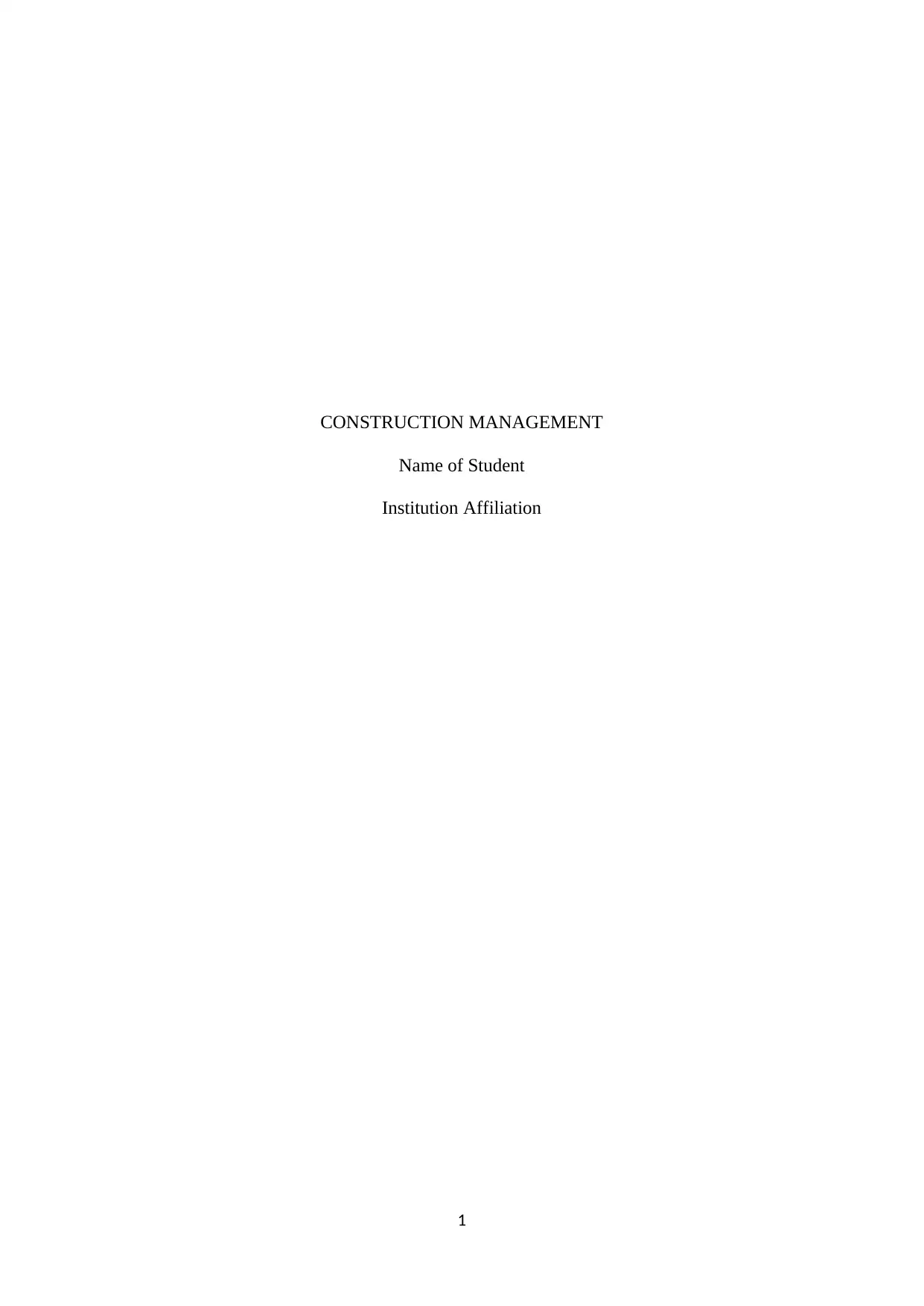
CONSTRUCTION MANAGEMENT
Name of Student
Institution Affiliation
1
Name of Student
Institution Affiliation
1
Paraphrase This Document
Need a fresh take? Get an instant paraphrase of this document with our AI Paraphraser
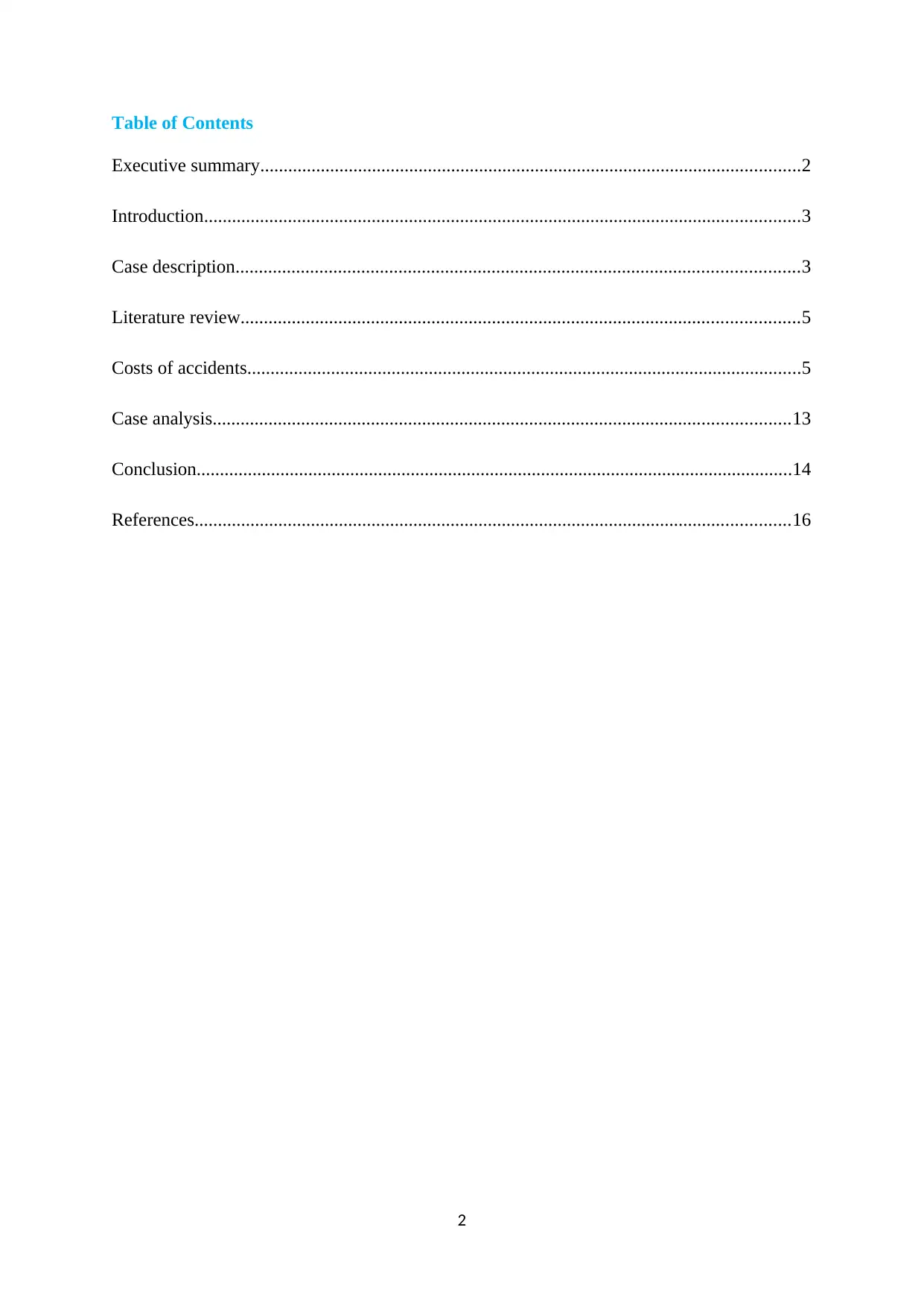
Table of Contents
Executive summary....................................................................................................................2
Introduction................................................................................................................................3
Case description.........................................................................................................................3
Literature review........................................................................................................................5
Costs of accidents.......................................................................................................................5
Case analysis............................................................................................................................13
Conclusion................................................................................................................................14
References................................................................................................................................16
2
Executive summary....................................................................................................................2
Introduction................................................................................................................................3
Case description.........................................................................................................................3
Literature review........................................................................................................................5
Costs of accidents.......................................................................................................................5
Case analysis............................................................................................................................13
Conclusion................................................................................................................................14
References................................................................................................................................16
2
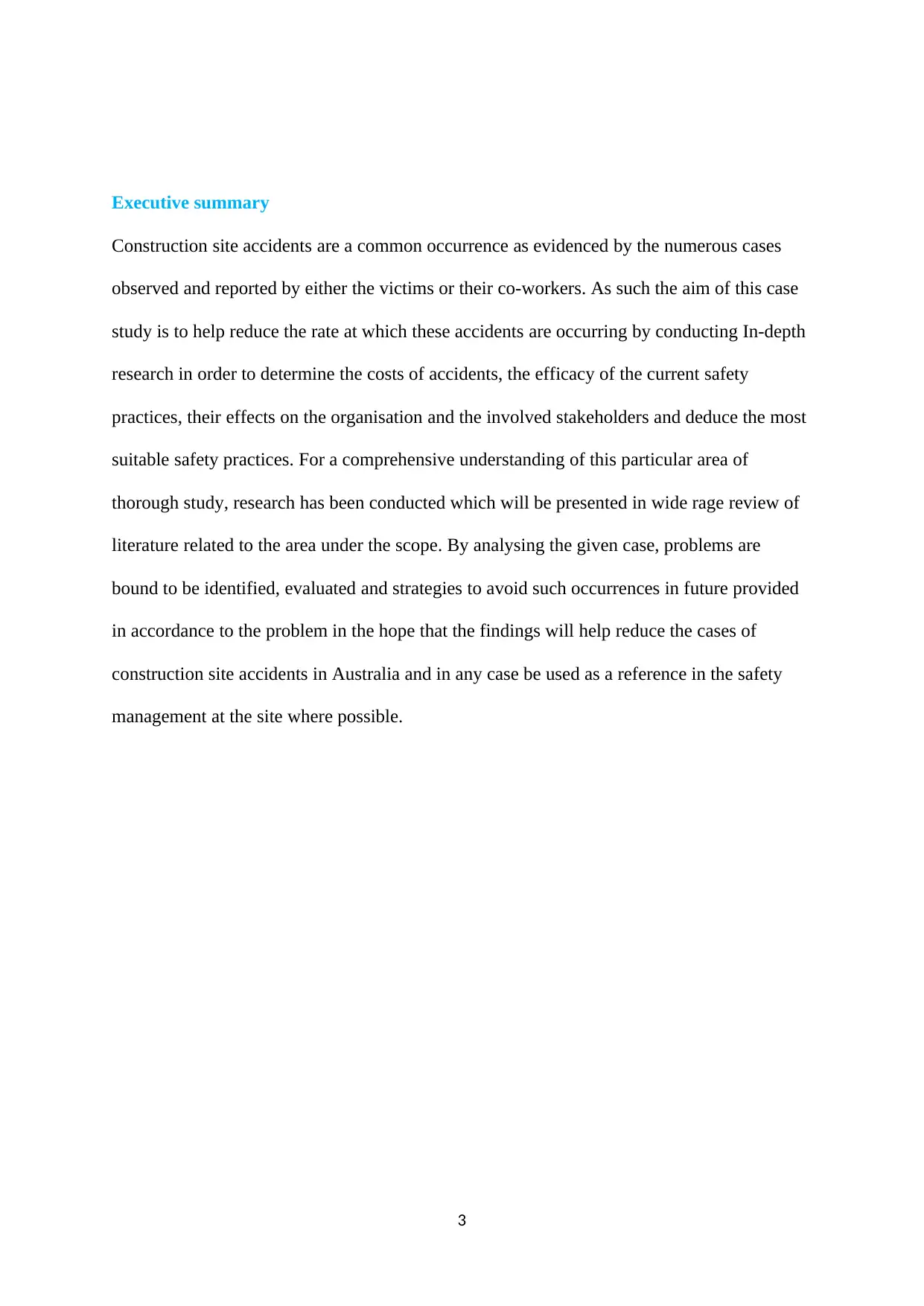
Executive summary
Construction site accidents are a common occurrence as evidenced by the numerous cases
observed and reported by either the victims or their co-workers. As such the aim of this case
study is to help reduce the rate at which these accidents are occurring by conducting In-depth
research in order to determine the costs of accidents, the efficacy of the current safety
practices, their effects on the organisation and the involved stakeholders and deduce the most
suitable safety practices. For a comprehensive understanding of this particular area of
thorough study, research has been conducted which will be presented in wide rage review of
literature related to the area under the scope. By analysing the given case, problems are
bound to be identified, evaluated and strategies to avoid such occurrences in future provided
in accordance to the problem in the hope that the findings will help reduce the cases of
construction site accidents in Australia and in any case be used as a reference in the safety
management at the site where possible.
3
Construction site accidents are a common occurrence as evidenced by the numerous cases
observed and reported by either the victims or their co-workers. As such the aim of this case
study is to help reduce the rate at which these accidents are occurring by conducting In-depth
research in order to determine the costs of accidents, the efficacy of the current safety
practices, their effects on the organisation and the involved stakeholders and deduce the most
suitable safety practices. For a comprehensive understanding of this particular area of
thorough study, research has been conducted which will be presented in wide rage review of
literature related to the area under the scope. By analysing the given case, problems are
bound to be identified, evaluated and strategies to avoid such occurrences in future provided
in accordance to the problem in the hope that the findings will help reduce the cases of
construction site accidents in Australia and in any case be used as a reference in the safety
management at the site where possible.
3
⊘ This is a preview!⊘
Do you want full access?
Subscribe today to unlock all pages.

Trusted by 1+ million students worldwide
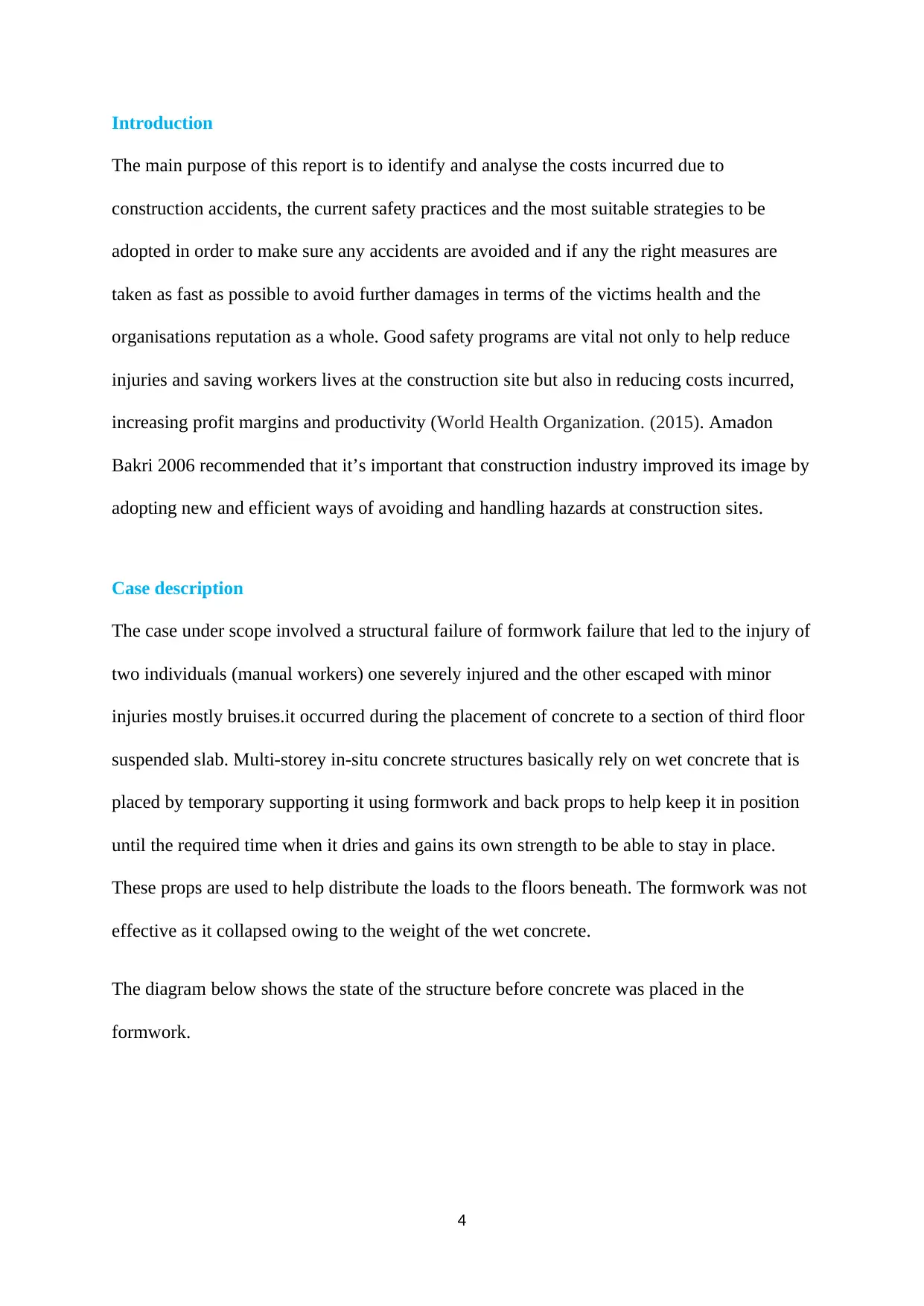
Introduction
The main purpose of this report is to identify and analyse the costs incurred due to
construction accidents, the current safety practices and the most suitable strategies to be
adopted in order to make sure any accidents are avoided and if any the right measures are
taken as fast as possible to avoid further damages in terms of the victims health and the
organisations reputation as a whole. Good safety programs are vital not only to help reduce
injuries and saving workers lives at the construction site but also in reducing costs incurred,
increasing profit margins and productivity (World Health Organization. (2015). Amadon
Bakri 2006 recommended that it’s important that construction industry improved its image by
adopting new and efficient ways of avoiding and handling hazards at construction sites.
Case description
The case under scope involved a structural failure of formwork failure that led to the injury of
two individuals (manual workers) one severely injured and the other escaped with minor
injuries mostly bruises.it occurred during the placement of concrete to a section of third floor
suspended slab. Multi-storey in-situ concrete structures basically rely on wet concrete that is
placed by temporary supporting it using formwork and back props to help keep it in position
until the required time when it dries and gains its own strength to be able to stay in place.
These props are used to help distribute the loads to the floors beneath. The formwork was not
effective as it collapsed owing to the weight of the wet concrete.
The diagram below shows the state of the structure before concrete was placed in the
formwork.
4
The main purpose of this report is to identify and analyse the costs incurred due to
construction accidents, the current safety practices and the most suitable strategies to be
adopted in order to make sure any accidents are avoided and if any the right measures are
taken as fast as possible to avoid further damages in terms of the victims health and the
organisations reputation as a whole. Good safety programs are vital not only to help reduce
injuries and saving workers lives at the construction site but also in reducing costs incurred,
increasing profit margins and productivity (World Health Organization. (2015). Amadon
Bakri 2006 recommended that it’s important that construction industry improved its image by
adopting new and efficient ways of avoiding and handling hazards at construction sites.
Case description
The case under scope involved a structural failure of formwork failure that led to the injury of
two individuals (manual workers) one severely injured and the other escaped with minor
injuries mostly bruises.it occurred during the placement of concrete to a section of third floor
suspended slab. Multi-storey in-situ concrete structures basically rely on wet concrete that is
placed by temporary supporting it using formwork and back props to help keep it in position
until the required time when it dries and gains its own strength to be able to stay in place.
These props are used to help distribute the loads to the floors beneath. The formwork was not
effective as it collapsed owing to the weight of the wet concrete.
The diagram below shows the state of the structure before concrete was placed in the
formwork.
4
Paraphrase This Document
Need a fresh take? Get an instant paraphrase of this document with our AI Paraphraser
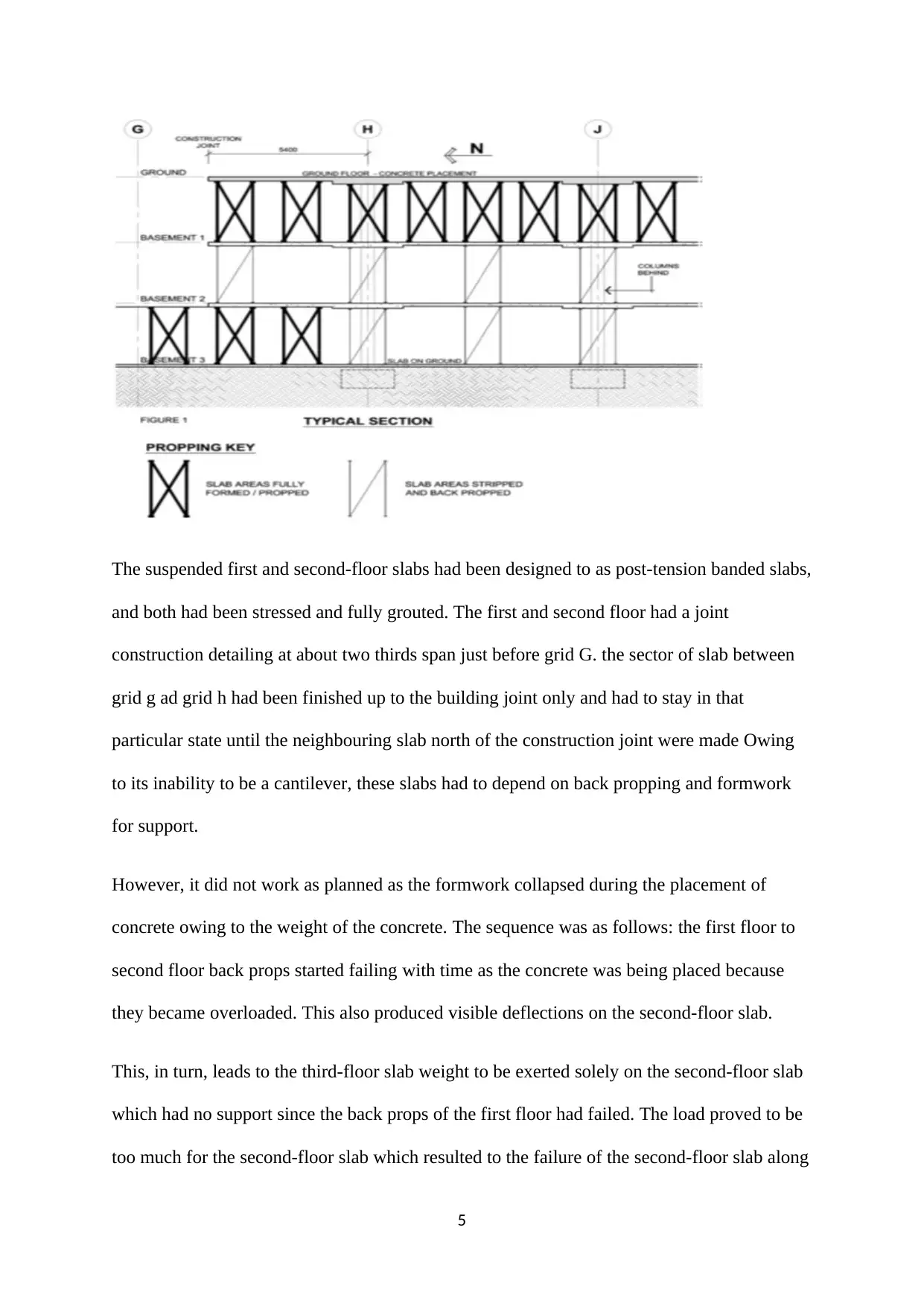
The suspended first and second-floor slabs had been designed to as post-tension banded slabs,
and both had been stressed and fully grouted. The first and second floor had a joint
construction detailing at about two thirds span just before grid G. the sector of slab between
grid g ad grid h had been finished up to the building joint only and had to stay in that
particular state until the neighbouring slab north of the construction joint were made Owing
to its inability to be a cantilever, these slabs had to depend on back propping and formwork
for support.
However, it did not work as planned as the formwork collapsed during the placement of
concrete owing to the weight of the concrete. The sequence was as follows: the first floor to
second floor back props started failing with time as the concrete was being placed because
they became overloaded. This also produced visible deflections on the second-floor slab.
This, in turn, leads to the third-floor slab weight to be exerted solely on the second-floor slab
which had no support since the back props of the first floor had failed. The load proved to be
too much for the second-floor slab which resulted to the failure of the second-floor slab along
5
and both had been stressed and fully grouted. The first and second floor had a joint
construction detailing at about two thirds span just before grid G. the sector of slab between
grid g ad grid h had been finished up to the building joint only and had to stay in that
particular state until the neighbouring slab north of the construction joint were made Owing
to its inability to be a cantilever, these slabs had to depend on back propping and formwork
for support.
However, it did not work as planned as the formwork collapsed during the placement of
concrete owing to the weight of the concrete. The sequence was as follows: the first floor to
second floor back props started failing with time as the concrete was being placed because
they became overloaded. This also produced visible deflections on the second-floor slab.
This, in turn, leads to the third-floor slab weight to be exerted solely on the second-floor slab
which had no support since the back props of the first floor had failed. The load proved to be
too much for the second-floor slab which resulted to the failure of the second-floor slab along
5
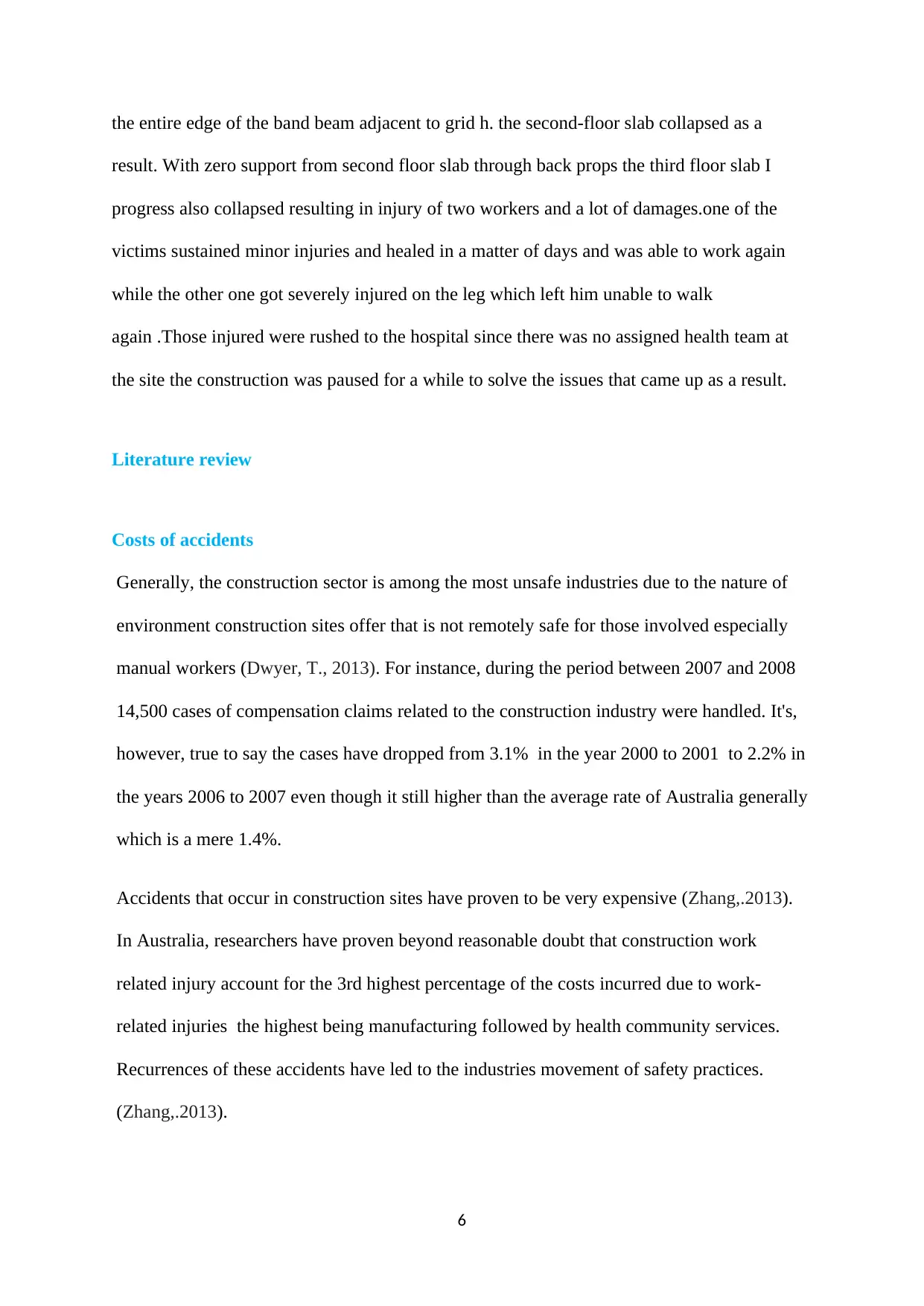
the entire edge of the band beam adjacent to grid h. the second-floor slab collapsed as a
result. With zero support from second floor slab through back props the third floor slab I
progress also collapsed resulting in injury of two workers and a lot of damages.one of the
victims sustained minor injuries and healed in a matter of days and was able to work again
while the other one got severely injured on the leg which left him unable to walk
again .Those injured were rushed to the hospital since there was no assigned health team at
the site the construction was paused for a while to solve the issues that came up as a result.
Literature review
Costs of accidents
Generally, the construction sector is among the most unsafe industries due to the nature of
environment construction sites offer that is not remotely safe for those involved especially
manual workers (Dwyer, T., 2013). For instance, during the period between 2007 and 2008
14,500 cases of compensation claims related to the construction industry were handled. It's,
however, true to say the cases have dropped from 3.1% in the year 2000 to 2001 to 2.2% in
the years 2006 to 2007 even though it still higher than the average rate of Australia generally
which is a mere 1.4%.
Accidents that occur in construction sites have proven to be very expensive (Zhang,.2013).
In Australia, researchers have proven beyond reasonable doubt that construction work
related injury account for the 3rd highest percentage of the costs incurred due to work-
related injuries the highest being manufacturing followed by health community services.
Recurrences of these accidents have led to the industries movement of safety practices.
(Zhang,.2013).
6
result. With zero support from second floor slab through back props the third floor slab I
progress also collapsed resulting in injury of two workers and a lot of damages.one of the
victims sustained minor injuries and healed in a matter of days and was able to work again
while the other one got severely injured on the leg which left him unable to walk
again .Those injured were rushed to the hospital since there was no assigned health team at
the site the construction was paused for a while to solve the issues that came up as a result.
Literature review
Costs of accidents
Generally, the construction sector is among the most unsafe industries due to the nature of
environment construction sites offer that is not remotely safe for those involved especially
manual workers (Dwyer, T., 2013). For instance, during the period between 2007 and 2008
14,500 cases of compensation claims related to the construction industry were handled. It's,
however, true to say the cases have dropped from 3.1% in the year 2000 to 2001 to 2.2% in
the years 2006 to 2007 even though it still higher than the average rate of Australia generally
which is a mere 1.4%.
Accidents that occur in construction sites have proven to be very expensive (Zhang,.2013).
In Australia, researchers have proven beyond reasonable doubt that construction work
related injury account for the 3rd highest percentage of the costs incurred due to work-
related injuries the highest being manufacturing followed by health community services.
Recurrences of these accidents have led to the industries movement of safety practices.
(Zhang,.2013).
6
⊘ This is a preview!⊘
Do you want full access?
Subscribe today to unlock all pages.

Trusted by 1+ million students worldwide
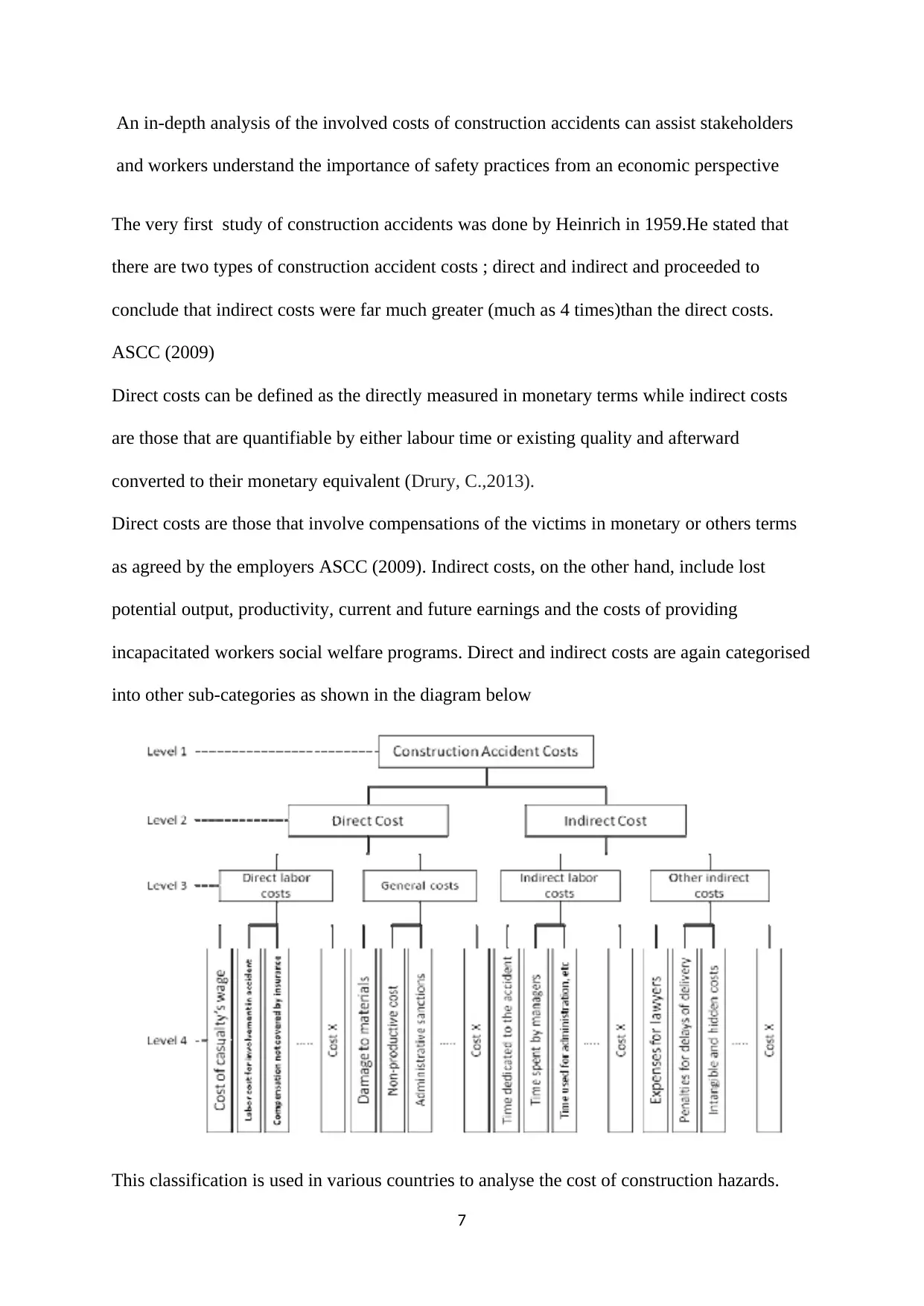
An in-depth analysis of the involved costs of construction accidents can assist stakeholders
and workers understand the importance of safety practices from an economic perspective
The very first study of construction accidents was done by Heinrich in 1959.He stated that
there are two types of construction accident costs ; direct and indirect and proceeded to
conclude that indirect costs were far much greater (much as 4 times)than the direct costs.
ASCC (2009)
Direct costs can be defined as the directly measured in monetary terms while indirect costs
are those that are quantifiable by either labour time or existing quality and afterward
converted to their monetary equivalent (Drury, C.,2013).
Direct costs are those that involve compensations of the victims in monetary or others terms
as agreed by the employers ASCC (2009). Indirect costs, on the other hand, include lost
potential output, productivity, current and future earnings and the costs of providing
incapacitated workers social welfare programs. Direct and indirect costs are again categorised
into other sub-categories as shown in the diagram below
This classification is used in various countries to analyse the cost of construction hazards.
7
and workers understand the importance of safety practices from an economic perspective
The very first study of construction accidents was done by Heinrich in 1959.He stated that
there are two types of construction accident costs ; direct and indirect and proceeded to
conclude that indirect costs were far much greater (much as 4 times)than the direct costs.
ASCC (2009)
Direct costs can be defined as the directly measured in monetary terms while indirect costs
are those that are quantifiable by either labour time or existing quality and afterward
converted to their monetary equivalent (Drury, C.,2013).
Direct costs are those that involve compensations of the victims in monetary or others terms
as agreed by the employers ASCC (2009). Indirect costs, on the other hand, include lost
potential output, productivity, current and future earnings and the costs of providing
incapacitated workers social welfare programs. Direct and indirect costs are again categorised
into other sub-categories as shown in the diagram below
This classification is used in various countries to analyse the cost of construction hazards.
7
Paraphrase This Document
Need a fresh take? Get an instant paraphrase of this document with our AI Paraphraser
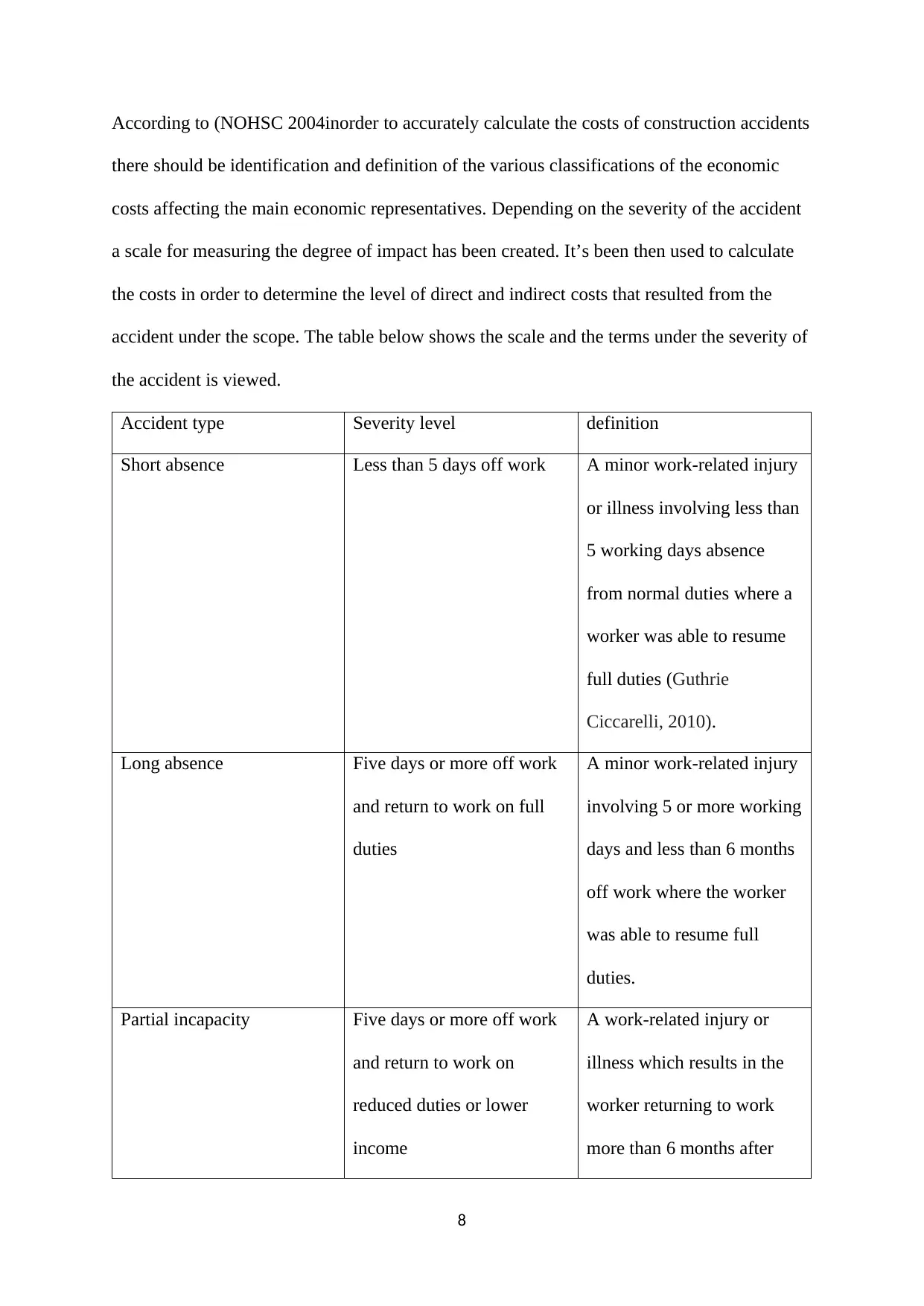
According to (NOHSC 2004inorder to accurately calculate the costs of construction accidents
there should be identification and definition of the various classifications of the economic
costs affecting the main economic representatives. Depending on the severity of the accident
a scale for measuring the degree of impact has been created. It’s been then used to calculate
the costs in order to determine the level of direct and indirect costs that resulted from the
accident under the scope. The table below shows the scale and the terms under the severity of
the accident is viewed.
Accident type Severity level definition
Short absence Less than 5 days off work A minor work-related injury
or illness involving less than
5 working days absence
from normal duties where a
worker was able to resume
full duties (Guthrie
Ciccarelli, 2010).
Long absence Five days or more off work
and return to work on full
duties
A minor work-related injury
involving 5 or more working
days and less than 6 months
off work where the worker
was able to resume full
duties.
Partial incapacity Five days or more off work
and return to work on
reduced duties or lower
income
A work-related injury or
illness which results in the
worker returning to work
more than 6 months after
8
there should be identification and definition of the various classifications of the economic
costs affecting the main economic representatives. Depending on the severity of the accident
a scale for measuring the degree of impact has been created. It’s been then used to calculate
the costs in order to determine the level of direct and indirect costs that resulted from the
accident under the scope. The table below shows the scale and the terms under the severity of
the accident is viewed.
Accident type Severity level definition
Short absence Less than 5 days off work A minor work-related injury
or illness involving less than
5 working days absence
from normal duties where a
worker was able to resume
full duties (Guthrie
Ciccarelli, 2010).
Long absence Five days or more off work
and return to work on full
duties
A minor work-related injury
involving 5 or more working
days and less than 6 months
off work where the worker
was able to resume full
duties.
Partial incapacity Five days or more off work
and return to work on
reduced duties or lower
income
A work-related injury or
illness which results in the
worker returning to work
more than 6 months after
8
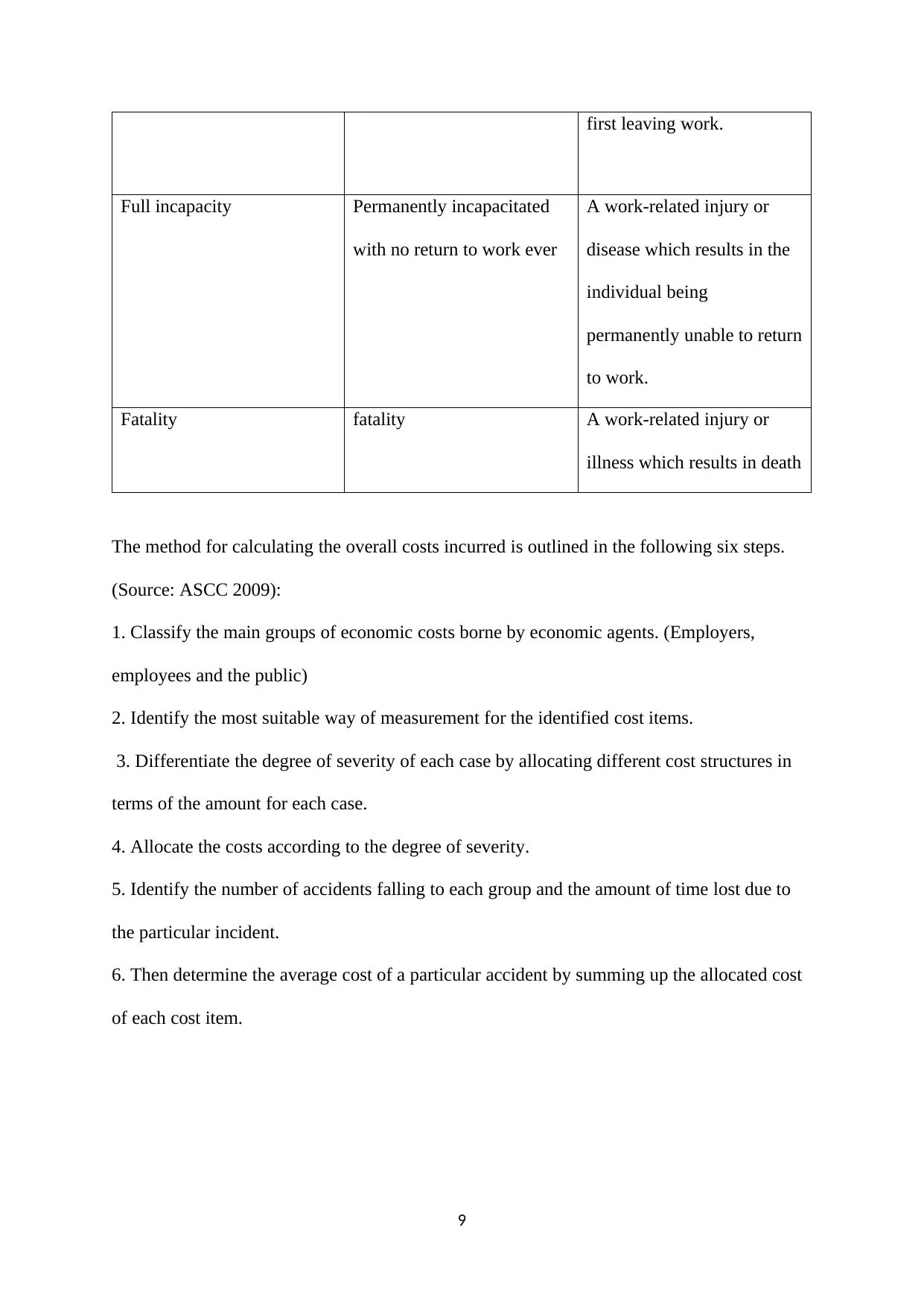
first leaving work.
Full incapacity Permanently incapacitated
with no return to work ever
A work-related injury or
disease which results in the
individual being
permanently unable to return
to work.
Fatality fatality A work-related injury or
illness which results in death
The method for calculating the overall costs incurred is outlined in the following six steps.
(Source: ASCC 2009):
1. Classify the main groups of economic costs borne by economic agents. (Employers,
employees and the public)
2. Identify the most suitable way of measurement for the identified cost items.
3. Differentiate the degree of severity of each case by allocating different cost structures in
terms of the amount for each case.
4. Allocate the costs according to the degree of severity.
5. Identify the number of accidents falling to each group and the amount of time lost due to
the particular incident.
6. Then determine the average cost of a particular accident by summing up the allocated cost
of each cost item.
9
Full incapacity Permanently incapacitated
with no return to work ever
A work-related injury or
disease which results in the
individual being
permanently unable to return
to work.
Fatality fatality A work-related injury or
illness which results in death
The method for calculating the overall costs incurred is outlined in the following six steps.
(Source: ASCC 2009):
1. Classify the main groups of economic costs borne by economic agents. (Employers,
employees and the public)
2. Identify the most suitable way of measurement for the identified cost items.
3. Differentiate the degree of severity of each case by allocating different cost structures in
terms of the amount for each case.
4. Allocate the costs according to the degree of severity.
5. Identify the number of accidents falling to each group and the amount of time lost due to
the particular incident.
6. Then determine the average cost of a particular accident by summing up the allocated cost
of each cost item.
9
⊘ This is a preview!⊘
Do you want full access?
Subscribe today to unlock all pages.

Trusted by 1+ million students worldwide
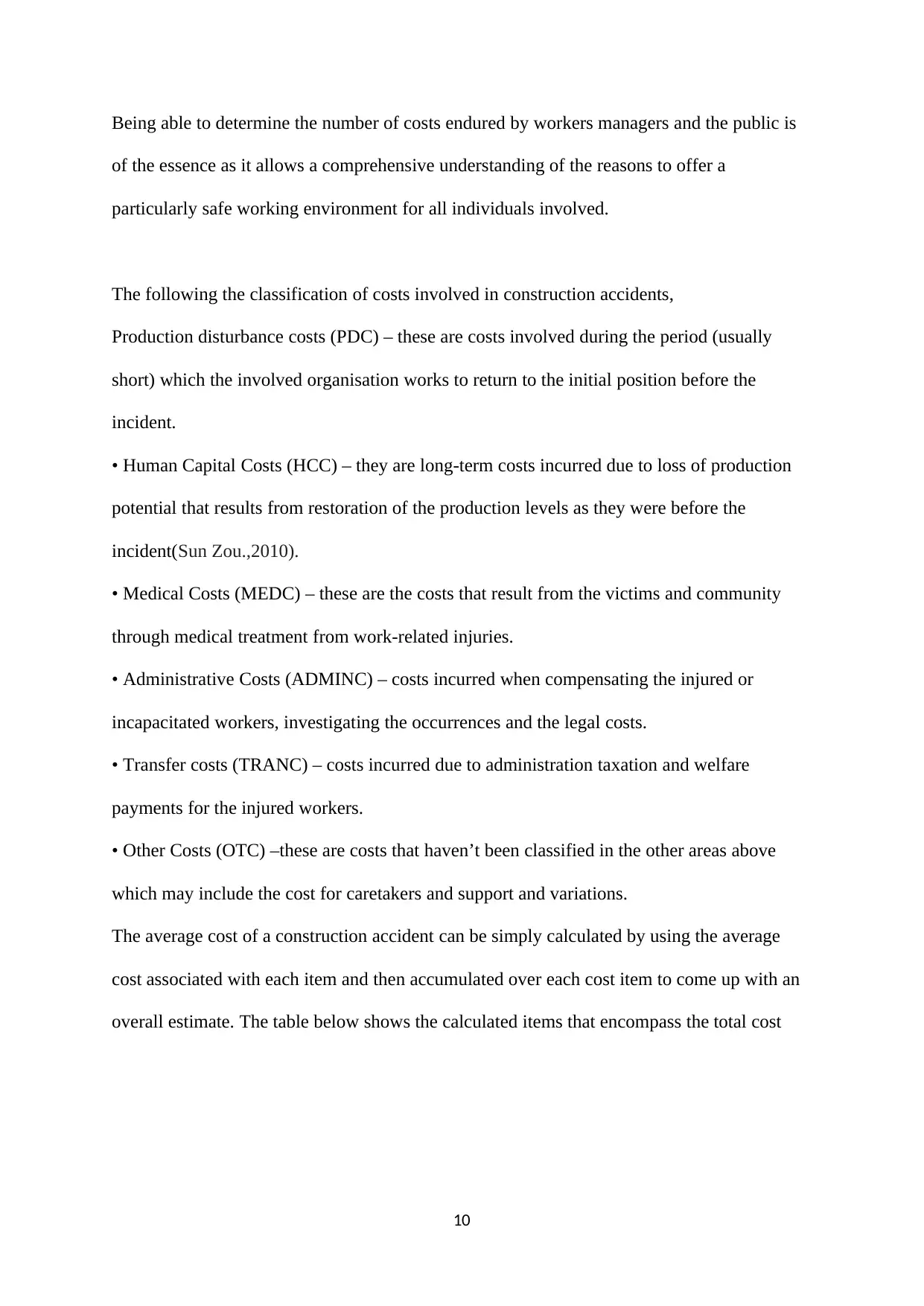
Being able to determine the number of costs endured by workers managers and the public is
of the essence as it allows a comprehensive understanding of the reasons to offer a
particularly safe working environment for all individuals involved.
The following the classification of costs involved in construction accidents,
Production disturbance costs (PDC) – these are costs involved during the period (usually
short) which the involved organisation works to return to the initial position before the
incident.
• Human Capital Costs (HCC) – they are long-term costs incurred due to loss of production
potential that results from restoration of the production levels as they were before the
incident(Sun Zou.,2010).
• Medical Costs (MEDC) – these are the costs that result from the victims and community
through medical treatment from work-related injuries.
• Administrative Costs (ADMINC) – costs incurred when compensating the injured or
incapacitated workers, investigating the occurrences and the legal costs.
• Transfer costs (TRANC) – costs incurred due to administration taxation and welfare
payments for the injured workers.
• Other Costs (OTC) –these are costs that haven’t been classified in the other areas above
which may include the cost for caretakers and support and variations.
The average cost of a construction accident can be simply calculated by using the average
cost associated with each item and then accumulated over each cost item to come up with an
overall estimate. The table below shows the calculated items that encompass the total cost
10
of the essence as it allows a comprehensive understanding of the reasons to offer a
particularly safe working environment for all individuals involved.
The following the classification of costs involved in construction accidents,
Production disturbance costs (PDC) – these are costs involved during the period (usually
short) which the involved organisation works to return to the initial position before the
incident.
• Human Capital Costs (HCC) – they are long-term costs incurred due to loss of production
potential that results from restoration of the production levels as they were before the
incident(Sun Zou.,2010).
• Medical Costs (MEDC) – these are the costs that result from the victims and community
through medical treatment from work-related injuries.
• Administrative Costs (ADMINC) – costs incurred when compensating the injured or
incapacitated workers, investigating the occurrences and the legal costs.
• Transfer costs (TRANC) – costs incurred due to administration taxation and welfare
payments for the injured workers.
• Other Costs (OTC) –these are costs that haven’t been classified in the other areas above
which may include the cost for caretakers and support and variations.
The average cost of a construction accident can be simply calculated by using the average
cost associated with each item and then accumulated over each cost item to come up with an
overall estimate. The table below shows the calculated items that encompass the total cost
10
Paraphrase This Document
Need a fresh take? Get an instant paraphrase of this document with our AI Paraphraser
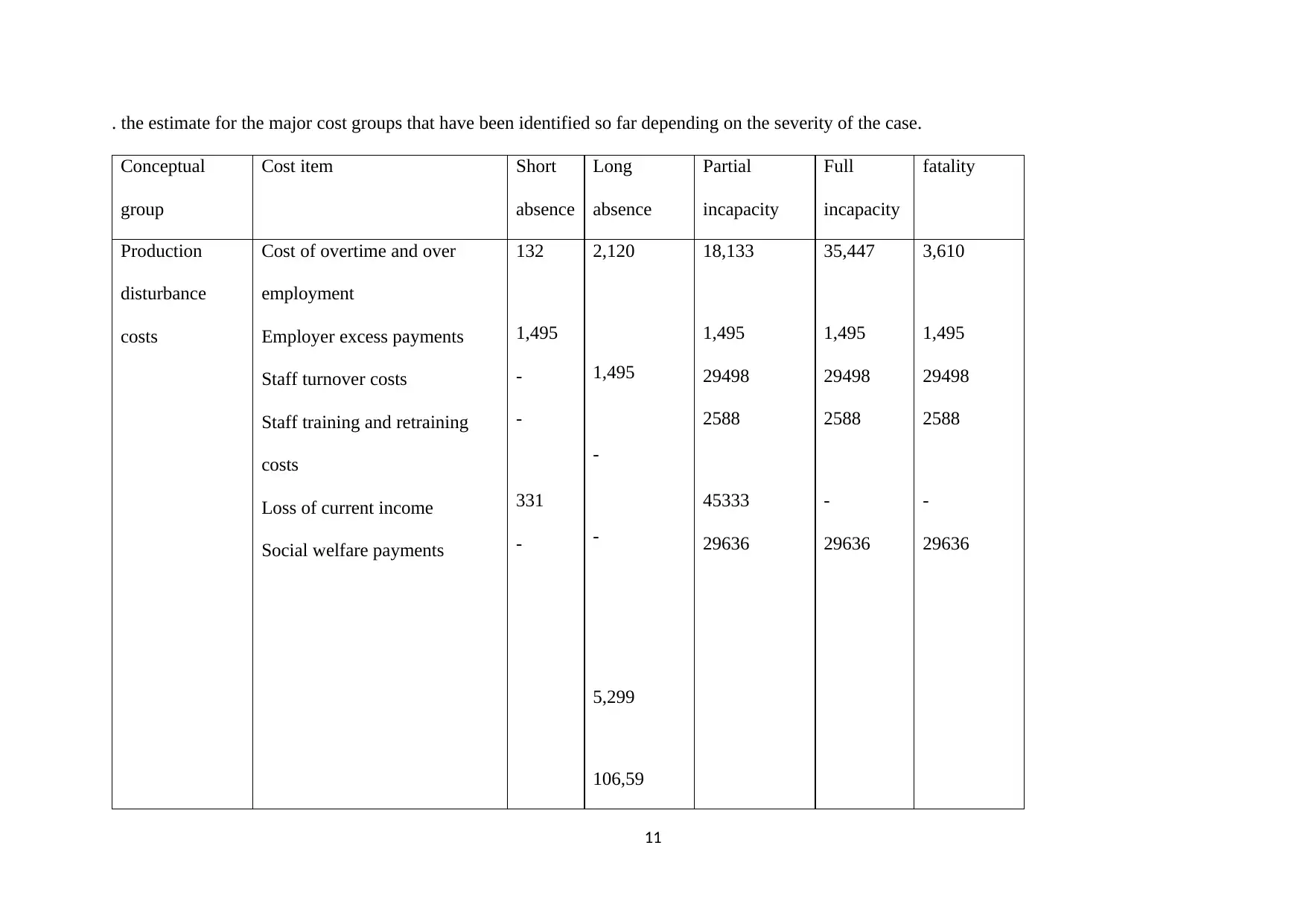
. the estimate for the major cost groups that have been identified so far depending on the severity of the case.
Conceptual
group
Cost item Short
absence
Long
absence
Partial
incapacity
Full
incapacity
fatality
Production
disturbance
costs
Cost of overtime and over
employment
Employer excess payments
Staff turnover costs
Staff training and retraining
costs
Loss of current income
Social welfare payments
132
1,495
-
-
331
-
2,120
1,495
-
-
5,299
106,59
18,133
1,495
29498
2588
45333
29636
35,447
1,495
29498
2588
-
29636
3,610
1,495
29498
2588
-
29636
11
Conceptual
group
Cost item Short
absence
Long
absence
Partial
incapacity
Full
incapacity
fatality
Production
disturbance
costs
Cost of overtime and over
employment
Employer excess payments
Staff turnover costs
Staff training and retraining
costs
Loss of current income
Social welfare payments
132
1,495
-
-
331
-
2,120
1,495
-
-
5,299
106,59
18,133
1,495
29498
2588
45333
29636
35,447
1,495
29498
2588
-
29636
3,610
1,495
29498
2588
-
29636
11
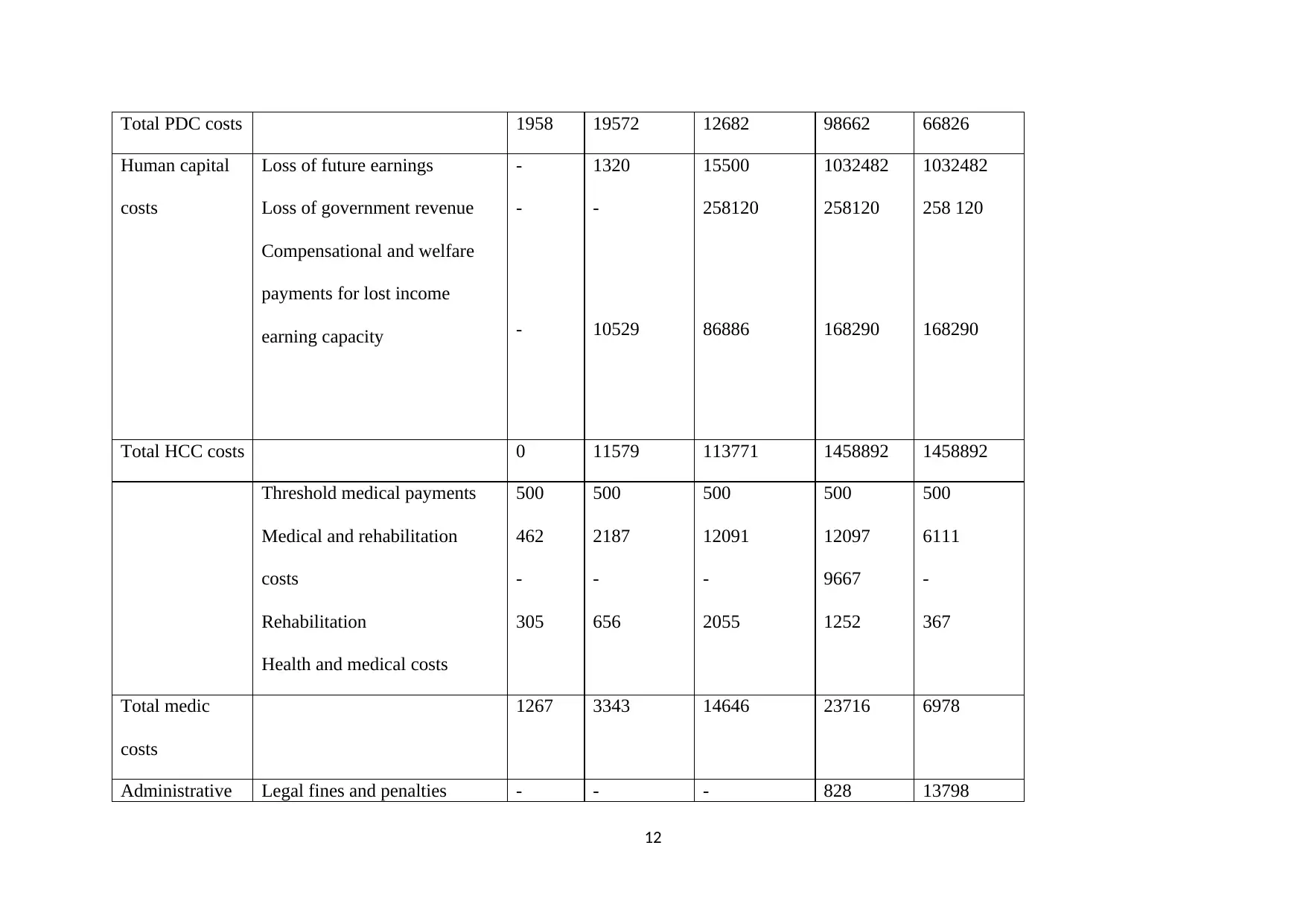
Total PDC costs 1958 19572 12682 98662 66826
Human capital
costs
Loss of future earnings
Loss of government revenue
Compensational and welfare
payments for lost income
earning capacity
-
-
-
1320
-
10529
15500
258120
86886
1032482
258120
168290
1032482
258 120
168290
Total HCC costs 0 11579 113771 1458892 1458892
Threshold medical payments
Medical and rehabilitation
costs
Rehabilitation
Health and medical costs
500
462
-
305
500
2187
-
656
500
12091
-
2055
500
12097
9667
1252
500
6111
-
367
Total medic
costs
1267 3343 14646 23716 6978
Administrative Legal fines and penalties - - - 828 13798
12
Human capital
costs
Loss of future earnings
Loss of government revenue
Compensational and welfare
payments for lost income
earning capacity
-
-
-
1320
-
10529
15500
258120
86886
1032482
258120
168290
1032482
258 120
168290
Total HCC costs 0 11579 113771 1458892 1458892
Threshold medical payments
Medical and rehabilitation
costs
Rehabilitation
Health and medical costs
500
462
-
305
500
2187
-
656
500
12091
-
2055
500
12097
9667
1252
500
6111
-
367
Total medic
costs
1267 3343 14646 23716 6978
Administrative Legal fines and penalties - - - 828 13798
12
⊘ This is a preview!⊘
Do you want full access?
Subscribe today to unlock all pages.

Trusted by 1+ million students worldwide
1 out of 19
Related Documents
Your All-in-One AI-Powered Toolkit for Academic Success.
+13062052269
info@desklib.com
Available 24*7 on WhatsApp / Email
![[object Object]](/_next/static/media/star-bottom.7253800d.svg)
Unlock your academic potential
Copyright © 2020–2025 A2Z Services. All Rights Reserved. Developed and managed by ZUCOL.




